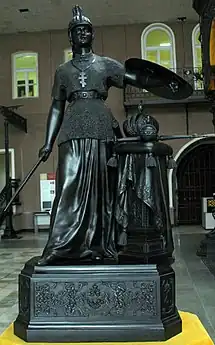Kasli iron sculpture
Kasli cast-iron sculpture was produced in Kasli (Southern Ural), from the mid-19th century. A large collection, including an elaborate pavilion from the 1900 Paris World Fair,[1] is displayed in the Yekaterinburg Museum of Fine Arts. There is also a Kasli Museum of Iron Sculptures. In 1860, the Kasli foundry was honoured with the Gold Award of the Free Economic Society. The following year, it was awarded a Silver Medal at the Saint Petersburg Textile Exhibition. There followed diplomas, silver and gold medals from international exhibitions in Paris (1867), Vienna (1873), Philadelphia (1876), Copenhagen (1888), Stockholm (1897) and Paris (1900).

Technical expertise

Kasli castings are characterised by skilled craftsmanship visible in exceptional clarity and smoothness of the metal surface. High-quality iron was smelted on a wood fire and cast in consistently fine sand.
Original works
Many notable sculptures and décor in Moscow and Saint Petersburg, including iron furniture at the Winter Palace, were produced at the Kasli factory. The Yekaterinburg Museum of Fine Arts holds a collection of original sculptures by Vasily Fedorovich Torokin and others.[2]
Reproductions
Some of the best examples are modelled on originals by well-known Russian and European sculptors including Peter Clodt von Jürgensburg and Eugene Lanceray.
Gallery
 Eugene Lanceray: Soldier with girl
Eugene Lanceray: Soldier with girl Cast-iron pavilion from 1900 Paris Exposition
Cast-iron pavilion from 1900 Paris Exposition
 Nikolay Laveretsky: "Russia" (1896)
Nikolay Laveretsky: "Russia" (1896)
References
- The Kasli Cast Iron Pavilion. At izi.travel. Retrieved 15 July 2020
- Castings made by Kasli masters, using their own models at izi.travel. Retrieved 15 July 2020